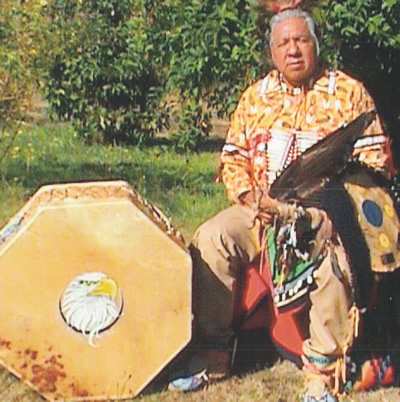 Hi, this is Vernon Kennedy, Paiute from the Burns Paiute tribe. I’d like to share this coyote story.
Hi, this is Vernon Kennedy, Paiute from the Burns Paiute tribe. I’d like to share this coyote story.
Coyote was with Esha who was going to be in a fight. As Esha was getting ready he told his brother don’t watch me even though you hear a lot of fighting. Don’t even peek. Coyote could not stand looking at his brother. He heard the fighting outside the tipi and decided to peek through a little crack.
At that instant, his brother was shot and fell to the ground. Esha’s enemy roasted him then celebrated the victory by dancing. Coyote tripped them to the dance. He waited until they were feasting. He knew he had to get one of his brother’s bones.
When they weren’t looking he grabbed the bone. He carried it with him everywhere he went. At night he would bury it in the ground. He did this for several days because his nosiness caused his brother’s death. He wanted to make up for it by carrying the bone with him.
One morning he heard a voice tell him to build a campfire. At first, the coyote thought he was hearing things, but the voice spoke again. Coyote looked around the camp. Then realized the voice belonged to Esha. He got some wood and built a big fire. His brother had come back to life. Coyote was so happy to see him alive that he did everything his brother wanted without complaining.
That’s the story of coyote and Esha.
Vernon Kennedy
Vernon Kennedy is a Paiute Indian and lives in Dallas, Oregon, and works for the Confederated Tribes of Grand Ronde. Both his parents are Paiutes. Relatives on his father’s side of the family are from Burns, Oregon. His mother is from the Paiute/Shoshone Reservation in McDermitt, Nevada and there are relatives there also. The tribe at one time occupied the eastern part of Oregon and the Northern part of Nevada. These areas are high deserts with sage, junipers, and forests in the higher altitudes.
Vernon is known for his storytelling and artwork. His storytelling is about animals such as coyotes, porcupines, and buffalo. In his artwork, he uses animals and natives as subjects. He has stories of a long time ago when the Paiute people were out gathering berries and coyotes came by to warn them the enemy was coming. The enemy was the Bannocks. The Paiute hid in caves as the Bannocks came and shot arrows into the caves. He believes that as native people continue giving the knowledge and sharing culture to non-Indian people, they will be able to learn more about native people and native ways.
Vernon is also a tribal historian. His dad used to tell him when he was a child that the family would travel in horse and wagon to different campsites. The grandpa would hunt for game to feed his family. The family would take the grandmother to set up camp and camp with her. They would help her dig for native foods for spring. Bitter roots were peeled and cleaned. They saw wild animals, ran around the hills having fun, caught squirrels, and fished in the creeks for fish. In the spring, the family would hunt for groundhog (a little bigger than the ground squirrel). In the winter, they would hunt rabbits. The grandfather would check for snared rabbits before the coyotes and crows found them. Both the groundhogs and rabbits were really good to eat. He tells stories of soldiers looking for his grandmother and her people while they were out digging berries and roots. The Paiutes have the rabbit dance and songs that are in the Paiute language. Their arts and crafts are marketed in stores in eastern Oregon. They are known for their baby boards and baskets. Artifacts have been found by archeologists in the Blue Mountains. In southeast Oregon around Malheur Lakes, artifacts were also found following flooding, which was repatriated back into the ground.
He shares native culture and tribal history to schools, children, adults, and churches in the greater Willamette Valley of Oregon. In his presentations to a wide variety of audiences, he speaks of protecting Mother Earth, the water, the mountains, and animals of the two-legged to four-legged variety. He sings and drums to tribal elders in retirement homes to encourage and support them. He also speaks about the history and treaties between the white people and the Paiute people when they were moved to Yakama in the winter of 1872. Losing over two million acres of land, the reservation now consists of 700 acres.
Vernon also writes articles for Smoke Signals, the tribal newspaper for the Confederated Tribes of Grand Ronde. He has received awards for his work in drug and alcohol prevention programs. He also has had recordings of native spiritual songs, and his own songs accompanied by the guitar.
Vernon Kennedy
1520 East Ellendale
Dallas, OR 97338
503-932-9449
Vernon.kennedy@grandronde.org
